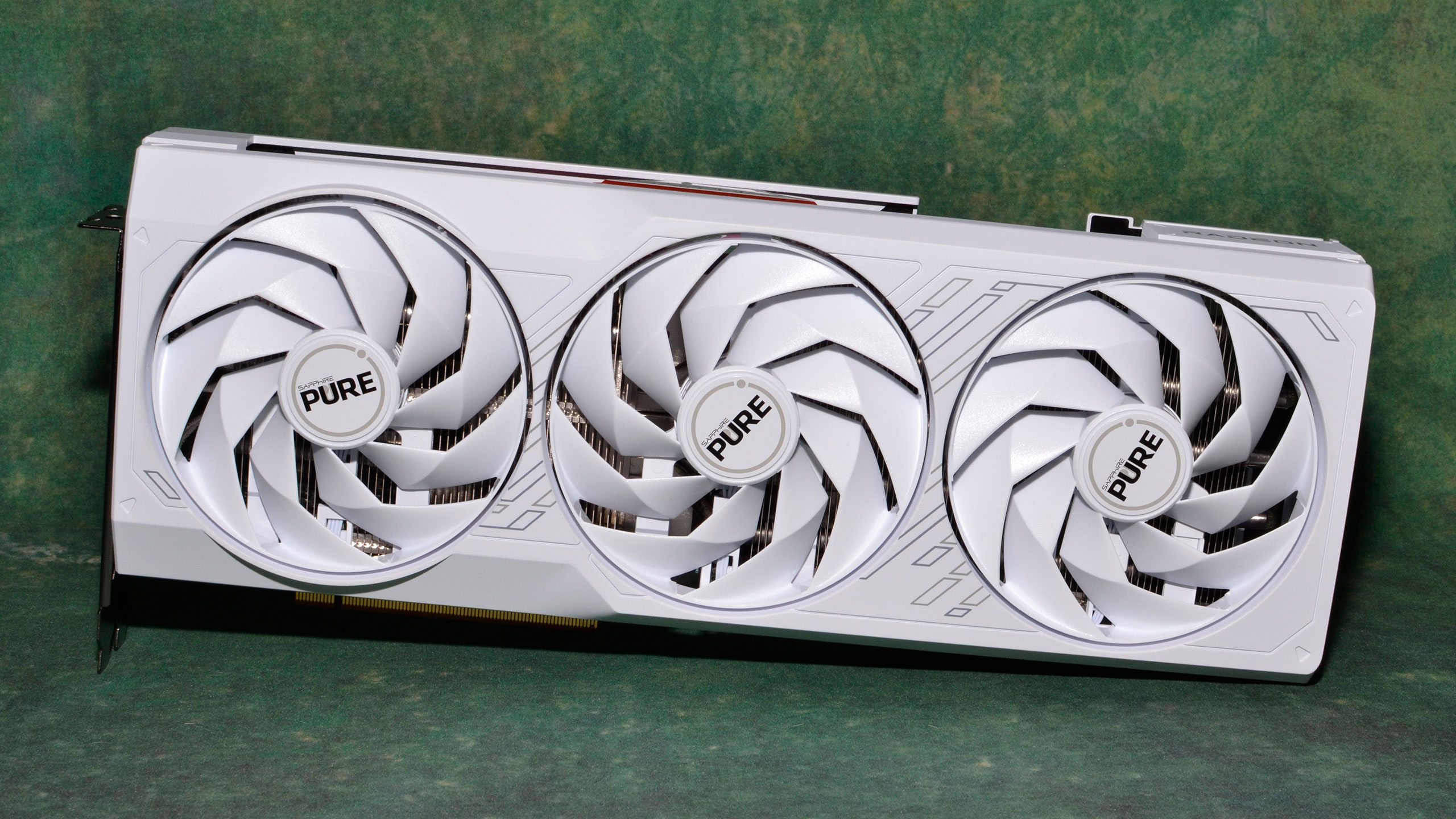Why you can trust Tom's Hardware
Depending on the games you play, the RX 7700 XT can be more than capable of handling 1440p, or it can struggle — that's usually only in games with lots of ray tracing effects, though. As usual, AMD has stronger rasterization performance and falls behind in ray tracing.
We begin with a global view of performance using the geometric mean of all 15 games in our test suite, including both the ray tracing and rasterization test suites. Then we'll have separate charts for the rasterization and ray tracing suites, plus charts for the individual games.

The Sapphire RX 7700 XT Pure and the XFX RX 7700 XT QICK 319 end up with identical overall results, down to the decimal. There's a bit of wiggle room in the various games, but that's almost certainly just margin of error in testing. Accorss our test suite, there's rarely more than a 1% difference, and often less than a 0.5% difference.
Looking at the surrounding GPUs, the 7700 XT lands just 5% ahead of the RX 6800, but 14% behind the RX 7800 XT. It's also 10% slower than the RX 6800 XT (not shown). Against Nvidia, it's 8% faster than the 4060 Ti — both 8GB and 16GB variants still performed the same at our 1440p ultra testing — and 19% behind the more expensive RTX 4070.
Generationally, if you don't look too closely at retail pricing, it's also 26% faster than the RX 6750 XT. That would be a decent jump in performance, and the MSRP is actually lower than the RX 6700 XT / 6750 XT, but both of those cards came out in the dark days of cryptocurrency GPU mining shortages and were heavily influenced by the increased demand at the time. These days, it's a $100 increase in price compared to the 6750 XT, and $130 more than the 6700 XT. You get what you pay for, in other words, with close to linear scaling between price and performance.
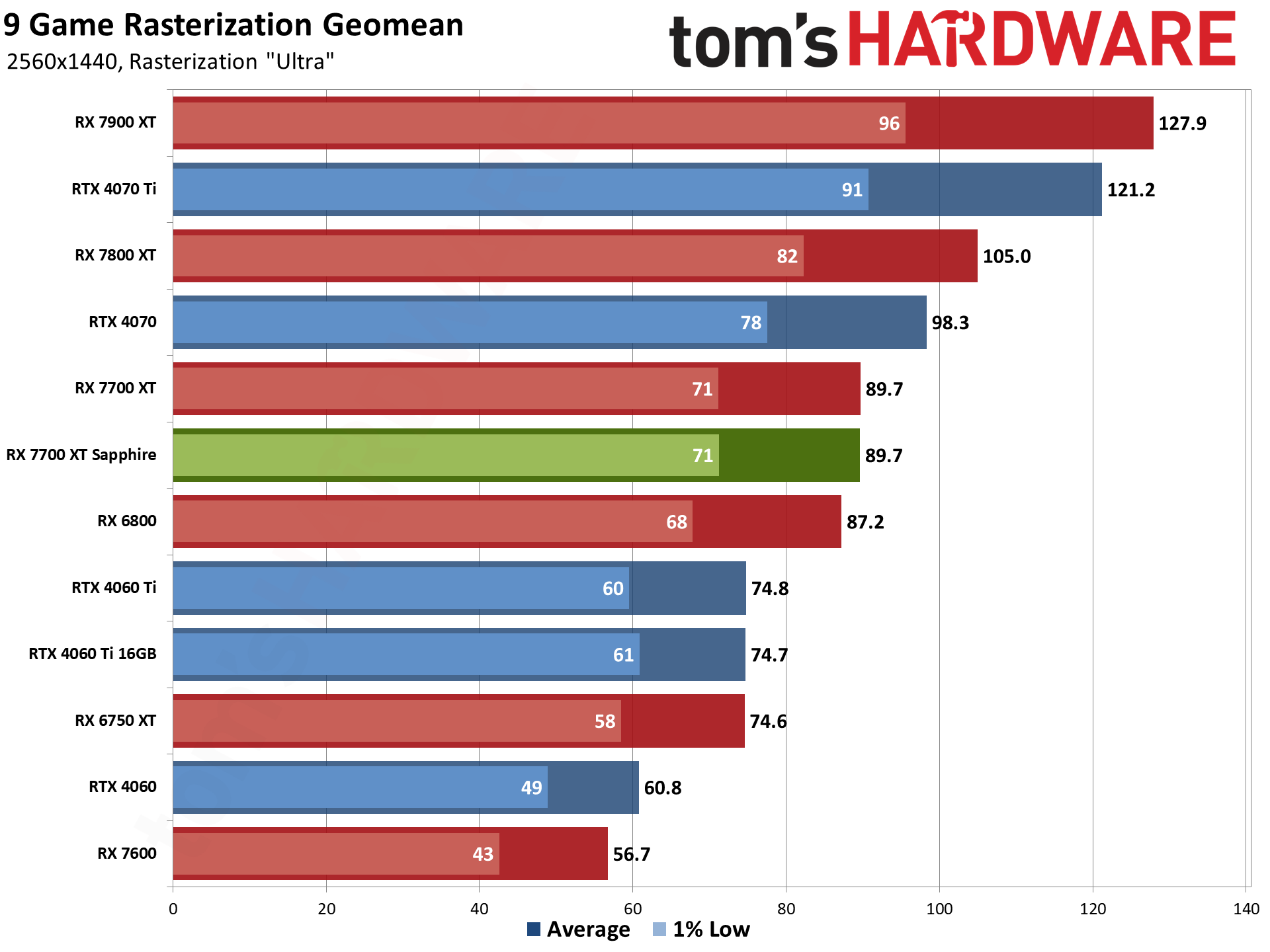


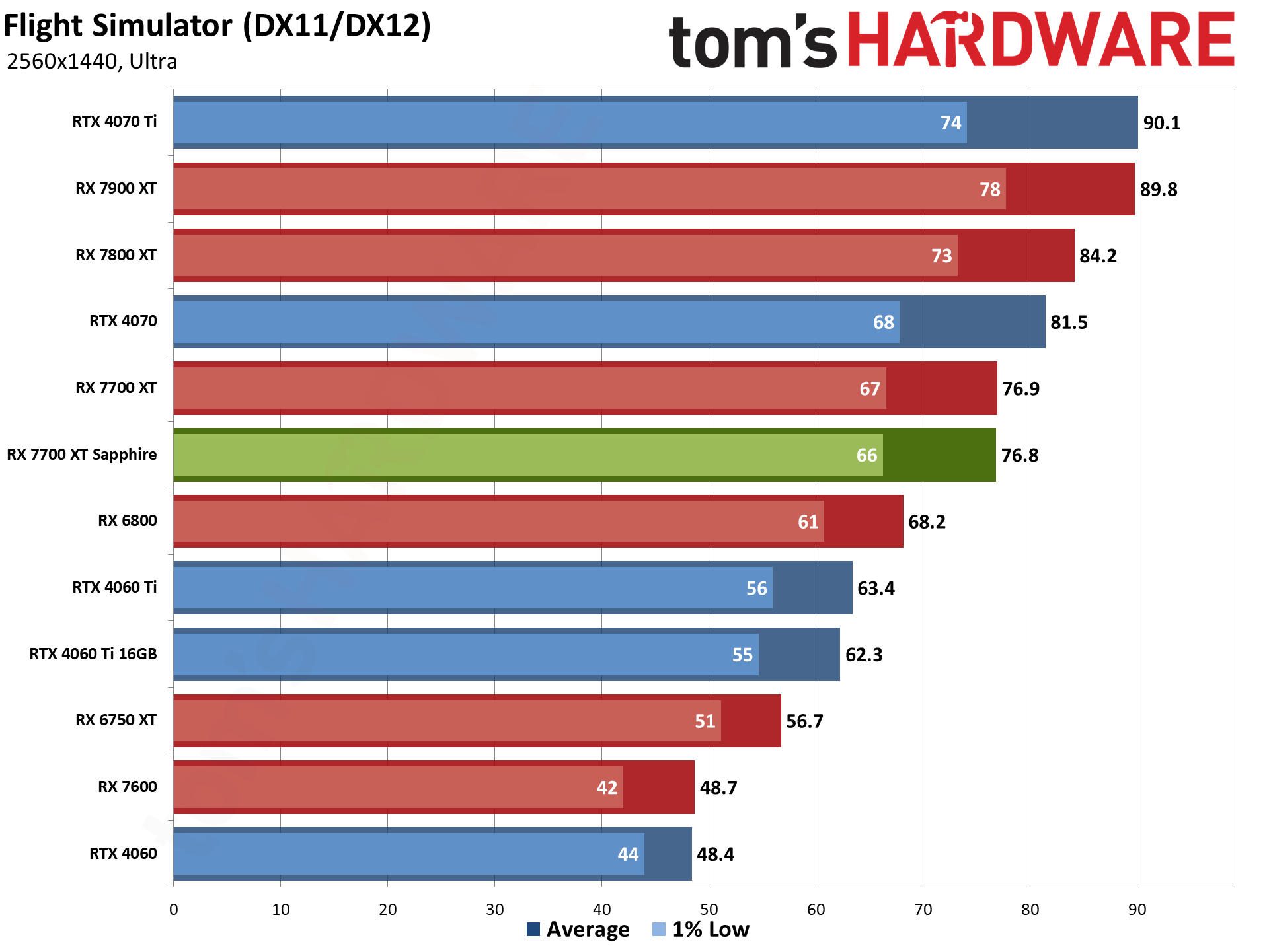
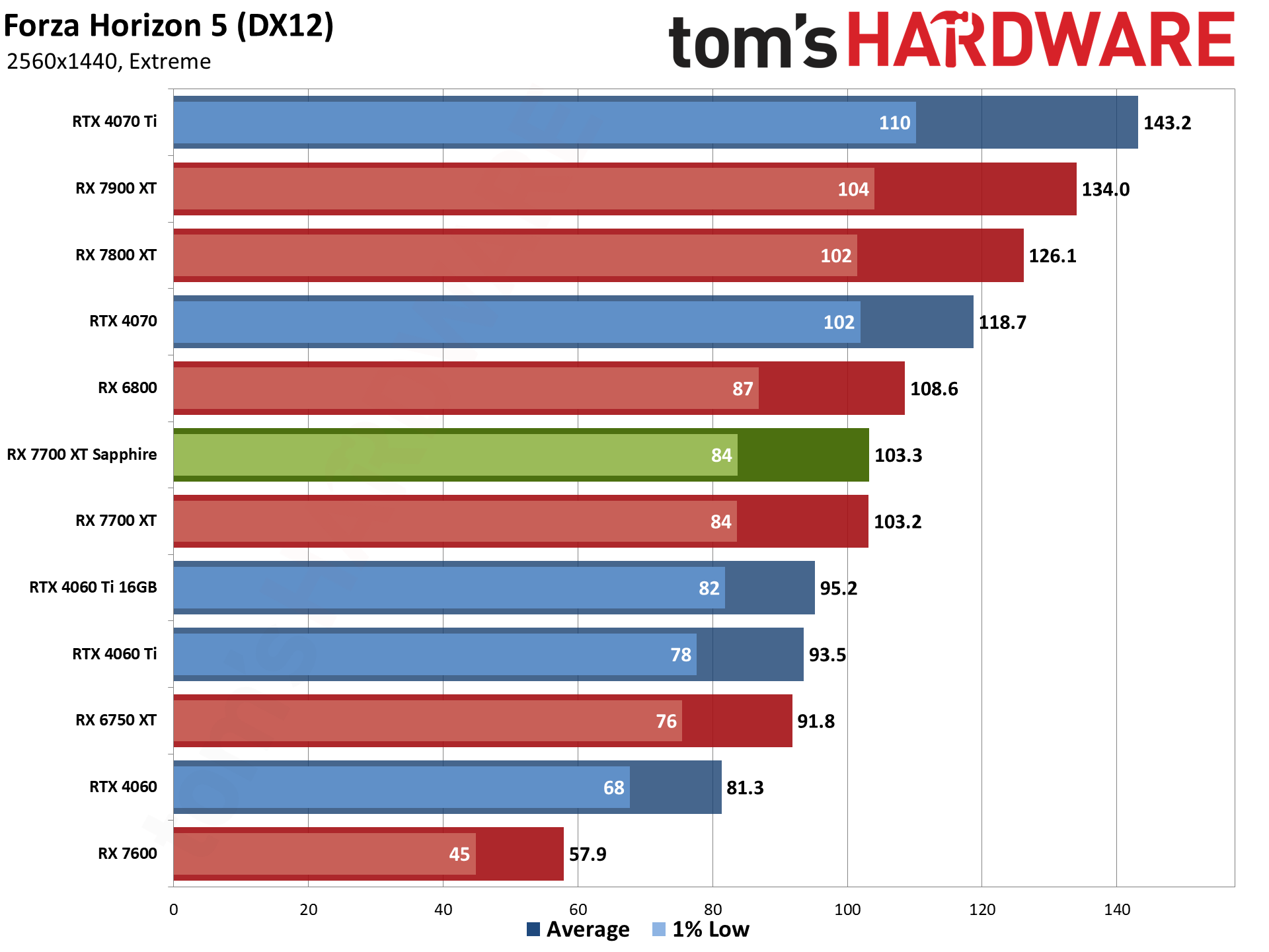
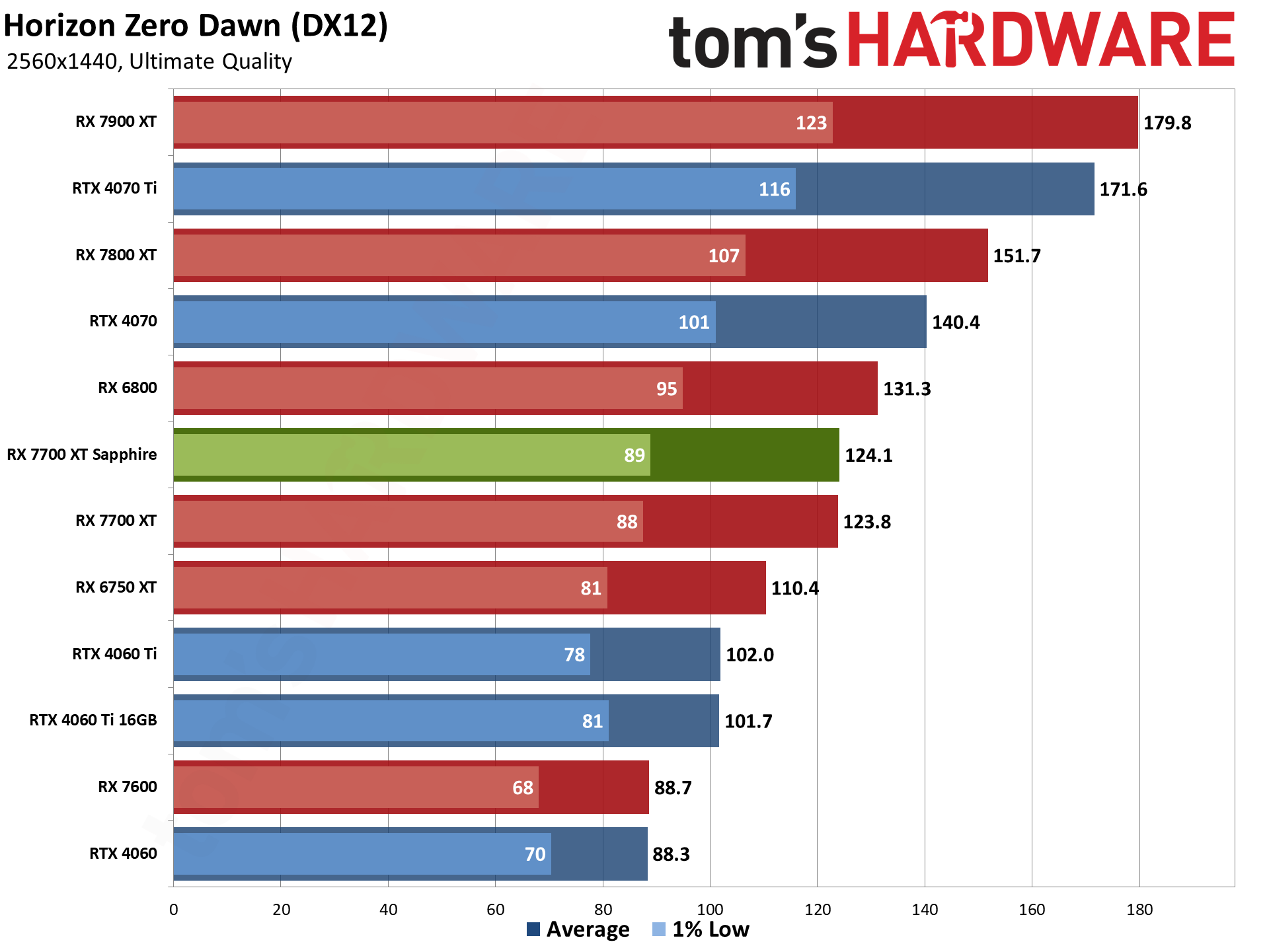
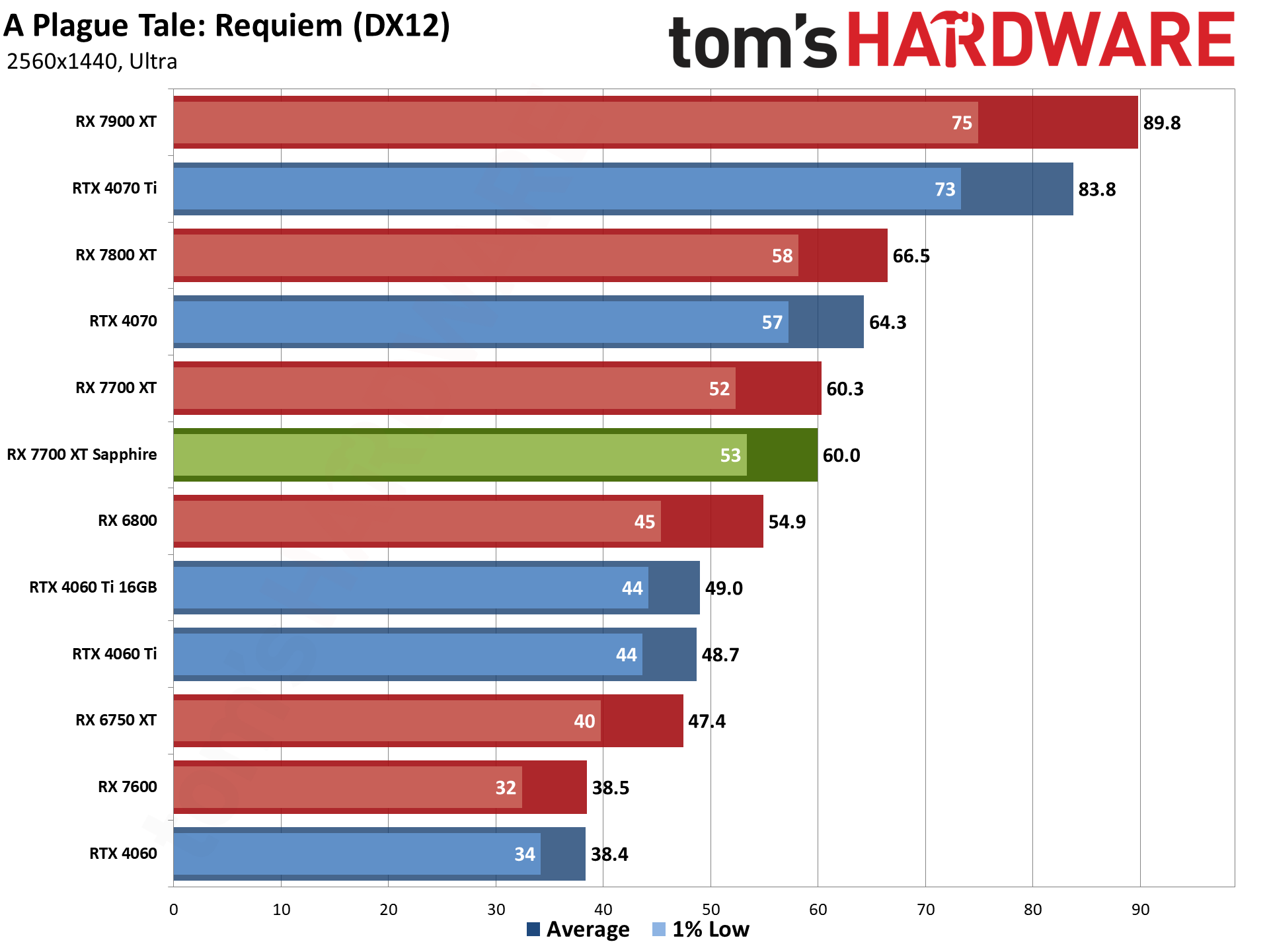
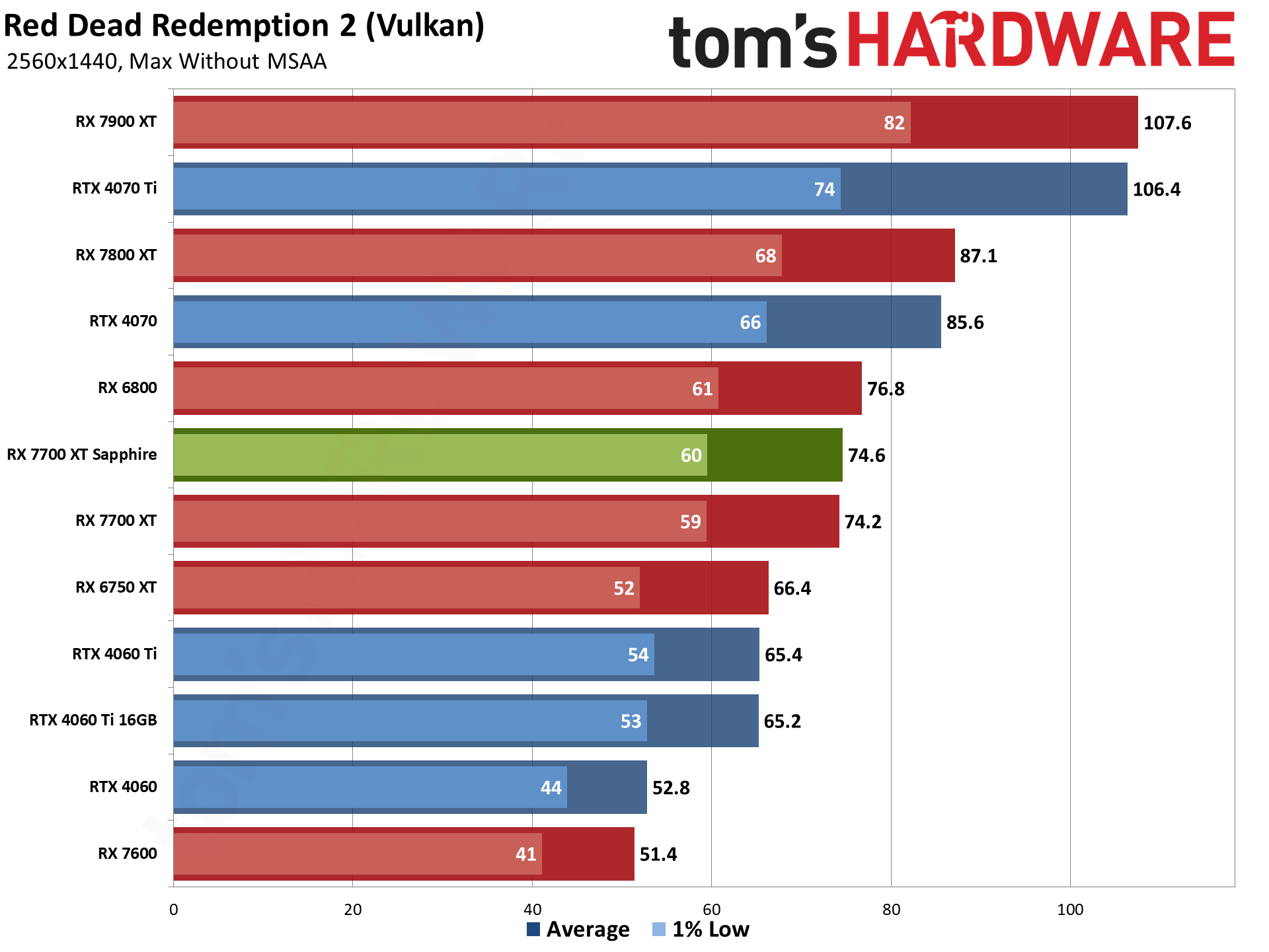


Our rasterization game suite shows aggregate performance of 90 fps. The lowest performing of the games, A Plague Tale: Requiem, just barely hits 60 fps, with 1% lows of 53 fps. Everything else does better, with minimums mostly at or above 60 fps. The only other exception is Total War: Warhammer 3 where the minimum fps is 48, but that game tends to have periodic stutters while loading data and isn't really dependent on having super high framerates.
The Sapphire and XFX 7700 XT cards remain tied, and the overall standings don't change much, other than the relative margins between AMD and Nvidia GPUs tilt in favor of AMD.
Speaking of which, across our rasterization test suite, the Sapphire card outperforms the RTX 4060 Ti 8GB by 20% overall, with a spread ranging from 4% (Total War: Warhammer 3) to 38% (Borderlands 3). There's not a single case in our test suite where the Nvidia 4060 Ti was faster at 1440p in pure rasterization. That might change if we looked at other games, but in general, AMD easily wins the rasterization battle.
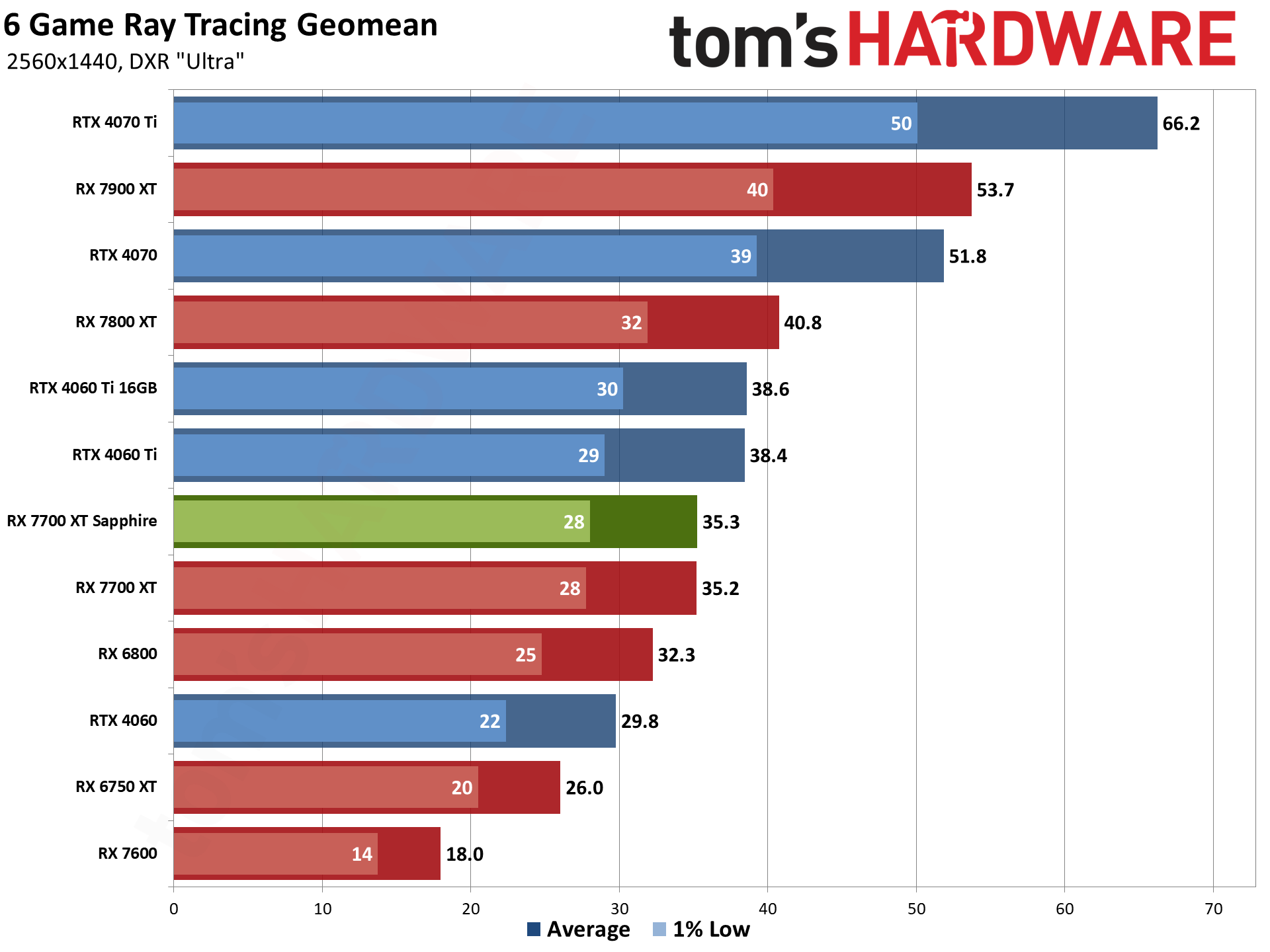
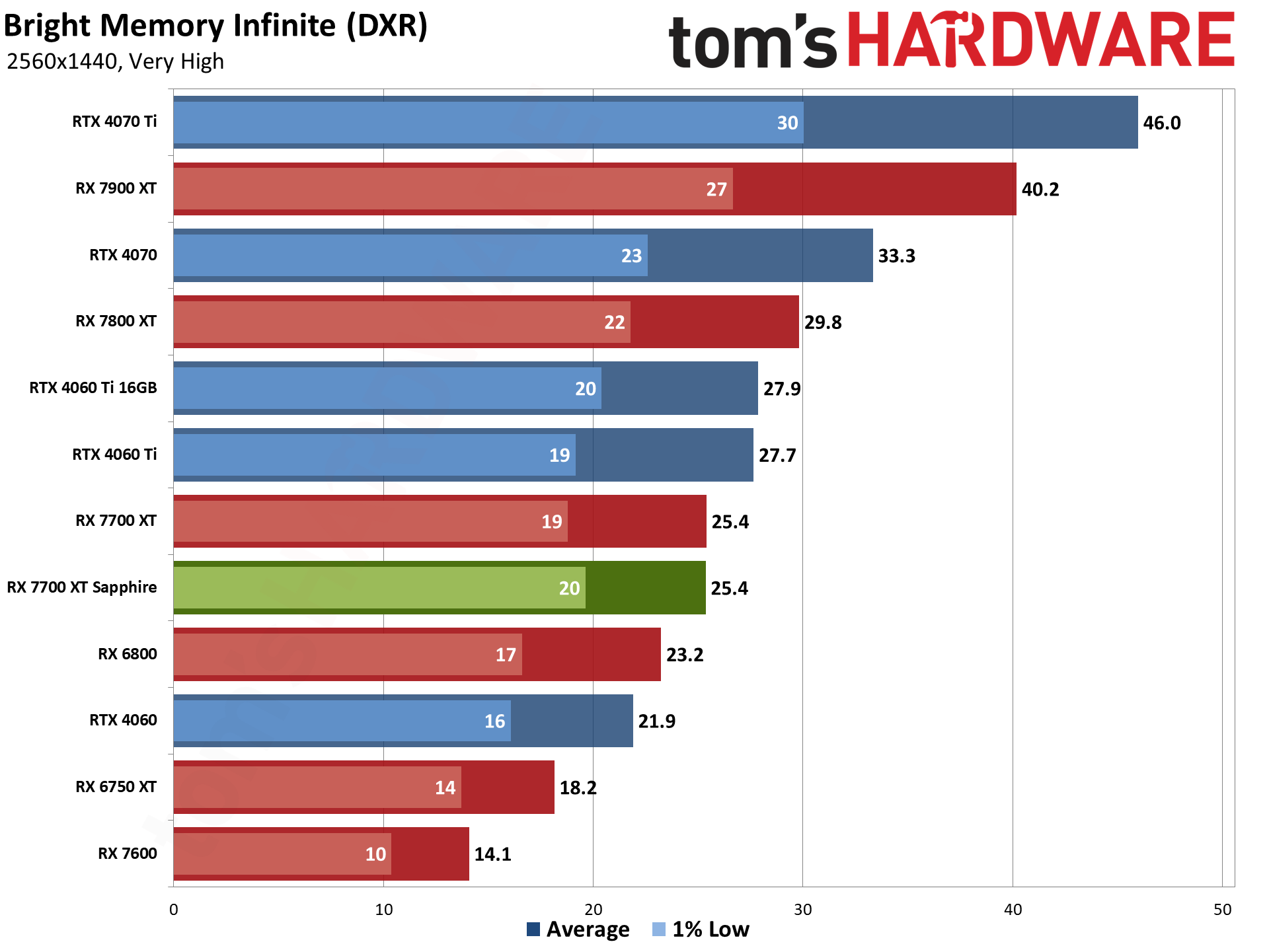


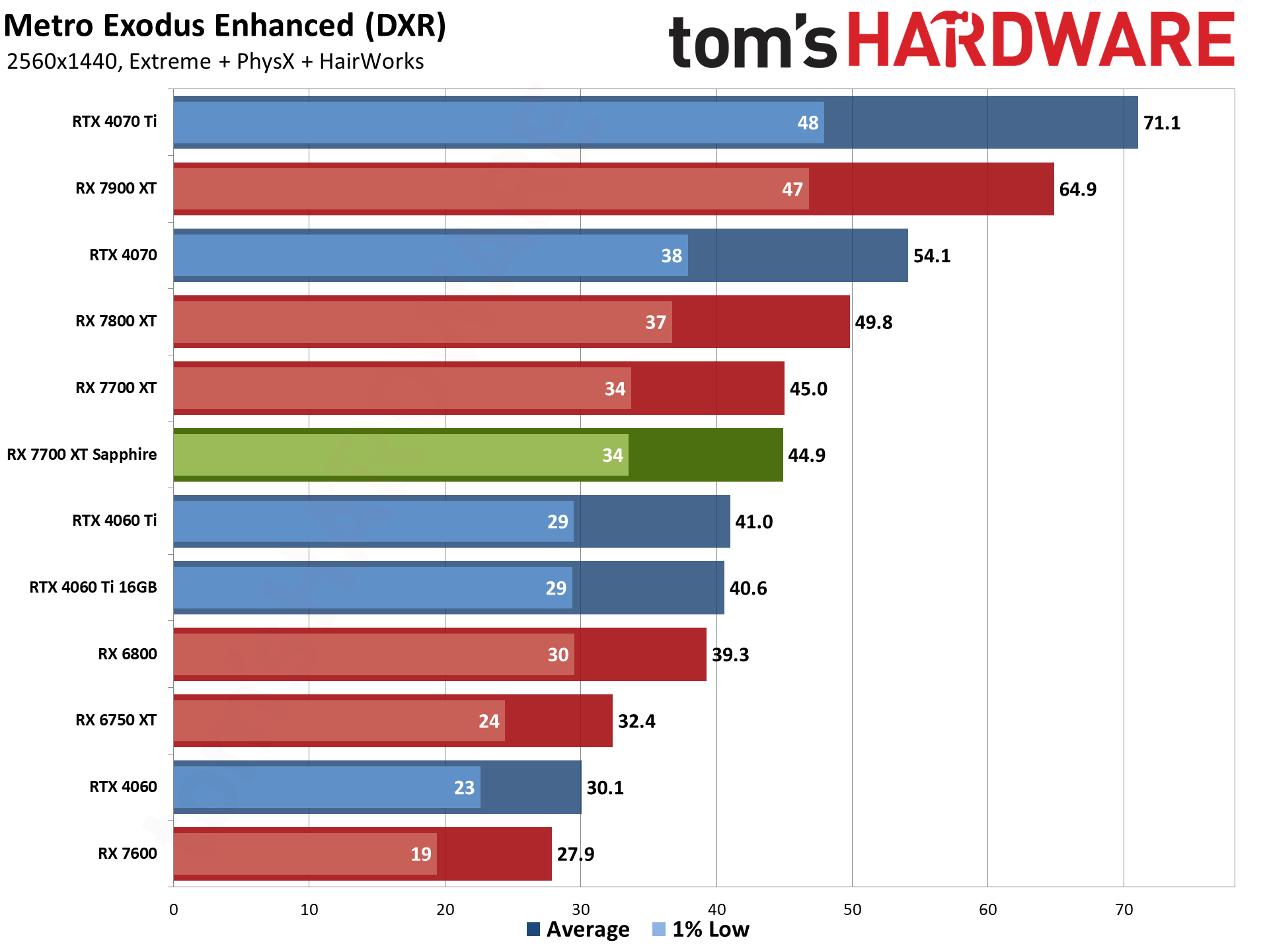

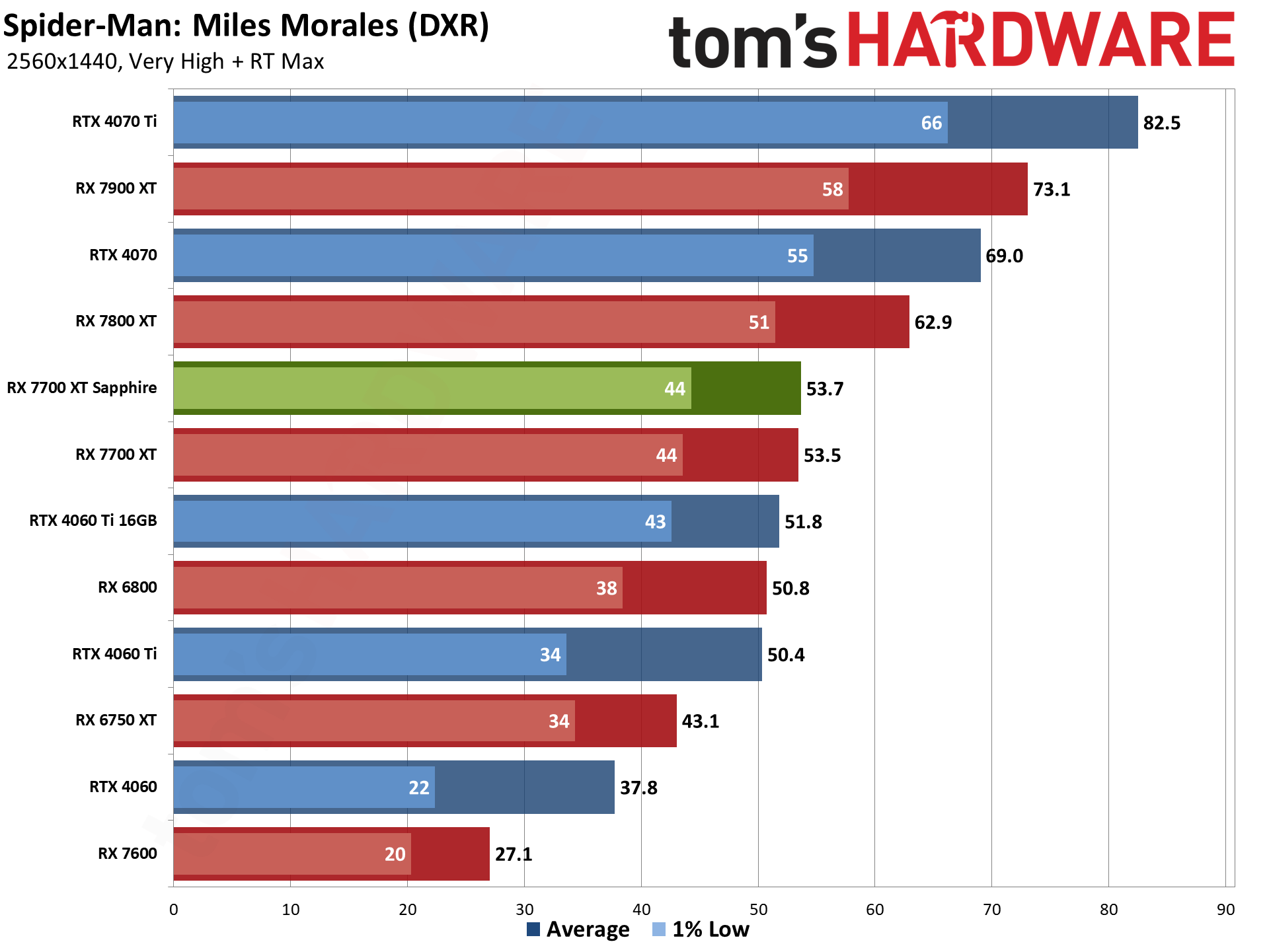
DXR swings things the other way, with the RTX 4060 Ti cards coming out slightly ahead of the RX 7700 XT. Sapphire's Pure card doesn't offer any additional performance compared to the XFX card, and a couple of the games fail to break 30 fps with full ray tracing enabled (at native resolution — FSR 2 would certainly help where supported).
Like we said, it's the standard story: AMD does great in rasterization, and falls behind in ray tracing. There are of course far, far more games that don't utilize ray tracing, so you can make that argument in favor of AMD if you want. But the more complex the ray tracing (see: Cyberpunk 2077 Phantom Liberty with full path tracing), the worse AMD's GPUs tend to perform.
If you're not looking at worst-case performance with full path tracing, things aren't too bad. The Sapphire 7700 XT beat the RTX 4060 Ti in both Metro Exodus Enhanced and Spider-Man: Miles Morales, while falling behind by 2–11 percent in Bright Memory Infinite, Control, and Cyberpunk 2077 (in RT-Ultra mode). Minecraft with full path tracing meanwhile heavily favors Nvidia, with the 7700 XT landing 36% behind the 4060 Ti.
- MORE: Best Graphics Cards
- MORE: GPU Benchmarks and Hierarchy
- MORE: All Graphics Content
Get Tom's Hardware's best news and in-depth reviews, straight to your inbox.
Current page: Sapphire RX 7700 XT Pure: 1440p Ultra Gaming Performance
Prev Page Sapphire RX 7700 XT Pure Review Next Page Sapphire RX 7700 XT Pure: 1080p Ultra Gaming Performance
Jarred Walton is a senior editor at Tom's Hardware focusing on everything GPU. He has been working as a tech journalist since 2004, writing for AnandTech, Maximum PC, and PC Gamer. From the first S3 Virge '3D decelerators' to today's GPUs, Jarred keeps up with all the latest graphics trends and is the one to ask about game performance.
-
hotaru.hino Reply
I would argue a lot of people, if they have the means to buy almost any car they want, will choose one car over another based on its color. Or even ask the dealer for a specific color if it's available.PEnns said:I don't know about you, but the majority of thinking people don't buy a car based on its color!!
About half the reason why I jumped on the motorcycle I bought a while ago was because being a Kawasaki, it didn't come in that obnoxious Kawasaki green (the other half was I was ready to move on from my first bike which it was replacing.) And I would say a non-trivial reason why I chose the car that I did was because I wanted to have matching colors with my bike.
Is it important in the grand scheme of things? No. But I had the choice. And if people didn't really care about color, why do you think that option exists? May as well go the Ford way and paint all cars black; it'll save them a lot in manufacturing. -
Good looks aside, i fear its pathetic 12GB VRAM renders it completely useless for modern gaming.Reply
-
punkncat Wow, future locked thread.Reply
For my own part, these cards are a bit of fresh air in the current market. It still stands that the MSRP on this, the 7800, and it's 6xxx forefathers is a bit confusing from a customer standpoint. For my own part, I love to see and often pick graphics cards as well as other components based solely on them NOT having unicorn puke spewing out of them. -
Geef Quick piece of unrelated info: I bought a ASRock Phantom Gaming Radeon RX 7800 XT 16GBReply
It is a very quiet card. Even while playing Starfield for several hours at a time. Lots of time tests. ;) -
JarredWaltonGPU Reply
It's why the ability to change your RGB lighting options exists. Default might be rainbow on most cards/mobos, but it's simple enough (usually) to set it to pure red, green, blue, or some other color. That's the crux of the issue. Adding lighting, but limiting it to a single color that can't be changed, is going half-way on a feature.punkncat said:Wow, future locked thread.
For my own part, these cards are a bit of fresh air in the current market. It still stands that the MSRP on this, the 7800, and it's 6xxx forefathers is a bit confusing from a customer standpoint. For my own part, I love to see and often pick graphics cards as well as other components based solely on them NOT having unicorn puke spewing out of them. -
punkncat ReplyJarredWaltonGPU said:It's why the ability to change your RGB lighting options exists. Default might be rainbow on most cards/mobos, but it's simple enough (usually) to set it to pure red, green, blue, or some other color. That's the crux of the issue. Adding lighting, but limiting it to a single color that can't be changed, is going half-way on a feature.
I don't disagree, per se, but also that this is a design decision based on what the manufacturer wanted to put forth in regard to their vision of the look they were going for. I feel that it is nice to have choices on this and that manufacturers are giving them, even when spartan.
edit- I would also add that in order to control RBG often involves downloading a companion app that may or may not play right with other lighting apps and so on. Without doubt, open and eating resources albeit a small amount, but have a couple of those running for this and that part to light the way you want adds up. -
AgentBirdnest I would have thought they'd give it blue lighting... cuz, ya know... sapphires. : PReply
I really love those fan blades. Cool angular shapes. Too bad I'd never ever see it when the computer is on, though. : P
I love silence... I'd pay an extra $30, even $50, for a card that has quieter cooling. But between a $480 7700XT with excellent cooling, and a $500 7800XT with adequate cooling... I'd pick the latter. AMD prices the 7700XT so weirdly...
That's awesome! Congrats! : )Geef said:Quick piece of unrelated info: I bought a ASRock Phantom Gaming Radeon RX 7800 XT 16GB
It is a very quiet card. Even while playing Starfield for several hours at a time. Lots of time tests. ;)
I feel like ASRock has really stepped up their game over the last couple of years, and makes some of the most compelling components now. -
nitrium It's also about twice as fast as the RTX 2060 (and costs $100 more than the 2060's launch price), and twice as fast as GTX 1080.Reply
I see neither of those cards in your charts. I know that the RTX 4060Ti is not (quite) twice as fast as an RTX 2060 in many (most?) games. The RTX 4070 is the first 4000 series card that gets there. -
wingfinger I don't care for lighting effects myself.Reply
What I don't like is that marketing and management probably think that they are providing an exciting and desirable product because of the lighting effects, instead of providing a reliable, great performance for the price product.
On a similar note, do people still buy graphics cars be because they are overclocked? I would buy an overlocked card, only because I don't want the lowest bin GPU possible. But, I would be looking for a mild overclock, never a high overclock.
